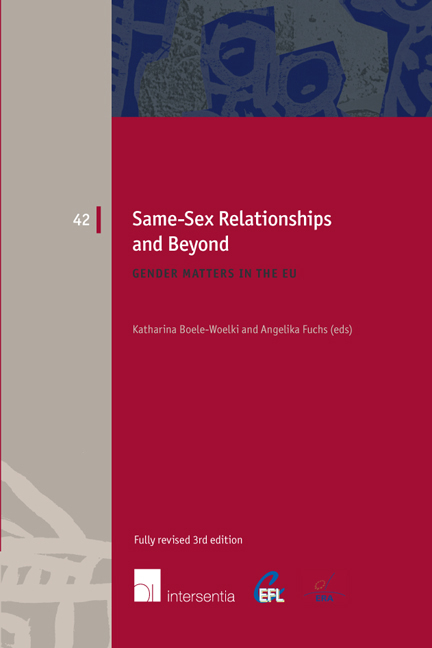Book contents
- Frontmatter
- Preface
- Contents
- List of Authors
- Part I Formalising a Same-Sex Relationship: Marriage and Partnership
- Part II Parenthood and Children's Rights
- Part III Gender Identity and Human Rights
- Homosexuality and Human Rights After Oliari v. Italy
- European Law Against Discrimination on Grounds of Sexual Orientation
- LGBT People as Refugees and Immigration Rights
- ‘The Legitimate Aim of Harmonising Body and Soul’ Changing Legal Gender: Family Life and Human Rights
- EUROPEAN FAMILY LAW SERIES
LGBT People as Refugees and Immigration Rights
from Part III - Gender Identity and Human Rights
Published online by Cambridge University Press: 29 September 2018
- Frontmatter
- Preface
- Contents
- List of Authors
- Part I Formalising a Same-Sex Relationship: Marriage and Partnership
- Part II Parenthood and Children's Rights
- Part III Gender Identity and Human Rights
- Homosexuality and Human Rights After Oliari v. Italy
- European Law Against Discrimination on Grounds of Sexual Orientation
- LGBT People as Refugees and Immigration Rights
- ‘The Legitimate Aim of Harmonising Body and Soul’ Changing Legal Gender: Family Life and Human Rights
- EUROPEAN FAMILY LAW SERIES
Summary
INTRODUCTION
This section deals with the legal implications that migration has on people who identify themselves as gay, lesbian, bisexual and transgender (LGBT). It explores the intersection of several major topics: refugee law, immigration and freedom of movement, on the one hand, and law and sexuality, on the other. The contribution consists of two main topical sub-sections of which the first deals with LGBT asylum seekers and the legal issues that may emerge in the course of the refugee status determination procedure, while the second sub-section deals with the immigration situation of same-sex partners who aspire to exercise their family reunification rights. What the two topical sections have in common is the intersection of gender/sexuality and migration, but the way in which the two topics are dealt with by the legal systems are very different: they are governed by different sets of norms on the national, European and international levels, and the motivations for invoking either of the two sets are, in principle, different, depending on whether migration is forced (in which case the person might more likely seek asylum) or voluntary (in which case the person might look for legal immigration routes). Due to the fact that the rules governing each of these life situations are so different, the topics will be dealt with separately in this chapter, which however by no means indicates that they could not both be useful for or tried by the same individual (having in mind, of course, that precisely because people might be willing to try different routes many countries limit transitions between asylum and immigration systems). One of the legal issues that seems to fall into both topics are the family reunification rights of refugees. These will be dealt with in the second part which deals with family reunifications issues. In this way, the first part remains reserved exclusively for issues concerning the refugee status determination procedure which gives raise to specific concerns in the context of LGBT applicants.
LGBT PEOPLE AS REFUGEES
Asylum claims based on the fear of persecution on the grounds of sexual orientation and gender identity first emerged in the early 1980s. They are a consequence of oppression and repression amounting to discrimination and persecution that LGBT individuals are experiencing around the globe.
- Type
- Chapter
- Information
- Same-Sex Relationships and BeyondGender Matters in the EU, pp. 205 - 230Publisher: IntersentiaPrint publication year: 2017



